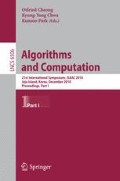Abstract
We investigate the unbalanced cut problems. A cut (A, B) is called unbalanced if the size of its smaller side is at most k (called k-size) or exactly k (called Ek-size), where k is an input parameter. An s-t cut (A, B) is called unbalanced if its s-side is of k-size or Ek-size. We consider three types of unbalanced cut problems, in which the quality of a cut is measured with respect to the capacity, the sparsity, and the conductance, respectively.
We show that even if the input graph is restricted to be a tree, the Ek-Sparsest Cut problem (to find an Ek-size cut with the minimum sparsity) is still NP-hard. We give a bicriteria approximation algorithm for the k-Sparsest Cut problem (to find a k-size cut with the minimum sparsity), which outputs a cut whose sparsity is at most O(logn) times the optimum and whose smaller side has size at most O(logn)k. As a consequence, this leads to a (O(logn), O(logn))-approximation algorithm for the Min k-Conductance problem (to find a k-size cut with the minimum conductance). We also prove that the Min k-Size s-t Cut problem is NP-hard and give an O(logn)-approximation algorithm for it.
Access this chapter
Tax calculation will be finalised at checkout
Purchases are for personal use only
Preview
Unable to display preview. Download preview PDF.
References
Armon, A., Zwick, U.: Multicriteria Global Minimum Cuts. Algorithmica 46(1), 15–26 (2006)
Arora, S., Lee, J., Naor, A.: Euclidean distortion and the sparsest cut. In: Proc. of STOC, pp. 553–562 (2005)
Arora, S., Rao, S., Vazirani, U.: Expander flows, geometric embeddings and graph partitioning. In: Proc. of STOC, pp. 222–231 (2004)
Engelberg, R., Könemann, J., Leonardi, S., (Seffi) Naor, J.: Cut problems in graphs with a budget constraint. Journal of Discrete Algorithms 5, 262–279 (2007)
Feige, U., Krauthgamer, R.: A polylogarithmic approximation of the minimum bisection. SIAM Review 48(1), 99–130 (2006); Preliminary version appears in: SIAM Journal on Computing, 31(4), 1090–1118 (2002)
Feige, U., Krauthgamer, R., Nissim, K.: On cutting a few vertices from a graph. Discrete Applied Mathematics 127, 643–649 (2003)
Garey, M., Johnson, D., Stockmeyer, L.: Some simplified NP-complete graph problems. Theoretical Computer Science 1, 237–267 (1976)
Girvan, M., Newman, M.E.J.: Community structure in social and biological networks. Proceedings of the National Academy of Sciences of the United States of America 99(12), 7821–7826 (2002)
Hayrapetyan, A., Kempe, D., Pál, M., Svitkina, Z.: Unbalanced Graph Cuts. In: Brodal, G.S., Leonardi, S. (eds.) ESA 2005. LNCS, vol. 3669, pp. 191–202. Springer, Heidelberg (2005)
Karger, D., Stein, C.: A new approach to the minimum cut problem. Journal of the ACM 43(4), 601–640 (1996)
Leskovec, J., Lang, K., Dasgupta, A., Mahoney, M.: Statistical properties of community structure in large social and information networks. In: Proc. of WWW, pp. 695–704 (2008)
Mann, C., Matula, D., Olinick, E.: The use of sparsest cut to reveal the hierarchical community structure of social networks. Social Networks 30, 223–234 (2008)
Nagamochi, H., Nishimura, K., Ibaraki, T.: Computing all small cuts in an undirected network. SIAM Journal on Discrete Mathematics 10(3), 469–481 (1997)
Räcke, H.: Optimal hierarchical decompositions for congestion minimization in networks. In: Proc. of STOC, pp. 255–264 (2008)
Svitkina, Z., Tardos, É.: Min-max multiway cut. In: Jansen, K., Khanna, S., Rolim, J.D.P., Ron, D. (eds.) RANDOM 2004 and APPROX 2004. LNCS, vol. 3122, pp. 207–218. Springer, Heidelberg (2004)
Vazirani, V.: Approximation Algorithms. Springer, Berlin (2001)
Author information
Authors and Affiliations
Editor information
Editors and Affiliations
Rights and permissions
Copyright information
© 2010 Springer-Verlag Berlin Heidelberg
About this paper
Cite this paper
Li, A., Zhang, P. (2010). Unbalanced Graph Partitioning. In: Cheong, O., Chwa, KY., Park, K. (eds) Algorithms and Computation. ISAAC 2010. Lecture Notes in Computer Science, vol 6506. Springer, Berlin, Heidelberg. https://doi.org/10.1007/978-3-642-17517-6_21
Download citation
DOI: https://doi.org/10.1007/978-3-642-17517-6_21
Publisher Name: Springer, Berlin, Heidelberg
Print ISBN: 978-3-642-17516-9
Online ISBN: 978-3-642-17517-6
eBook Packages: Computer ScienceComputer Science (R0)

